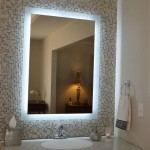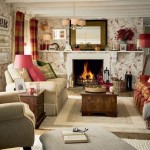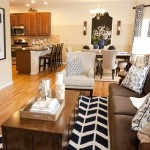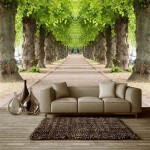Ideas On Decorating A Living Room
The living room often serves as the central hub of a home, a space for relaxation, entertainment, and social interaction. Its design significantly impacts the overall ambiance and reflects the homeowner's style. A well-decorated living room can foster a welcoming atmosphere and provide a comfortable retreat. This article explores various decorating ideas to transform a living room into a stylish and functional space.
Establishing a clear design style is crucial before commencing any decorating project. Popular styles include modern, minimalist, traditional, bohemian, and farmhouse, each with distinct characteristics. Modern design emphasizes clean lines, functionality, and neutral color palettes. Minimalist design focuses on simplicity and decluttering, using only essential furniture and decor. Traditional design incorporates classic elements, ornate details, and rich textures. Bohemian style embraces eclecticism, vibrant colors, and global influences. Farmhouse style exudes rustic charm, utilizing natural materials and vintage accents.
Color palettes significantly impact the mood and atmosphere of a living room. Neutral palettes create a calming and sophisticated feel, while vibrant colors inject energy and personality. Cool colors, such as blues and greens, promote relaxation, whereas warm colors, like reds and yellows, foster a sense of warmth and intimacy. Considering the room's natural light is essential when selecting colors. Darker rooms may benefit from lighter shades, while brighter rooms can handle bolder hues.
Furniture arrangement plays a crucial role in optimizing space and functionality. The focal point of the living room, often a fireplace or entertainment center, should dictate the furniture placement. Creating conversation areas by arranging sofas and chairs facing each other promotes social interaction. Leaving sufficient space between furniture pieces allows for easy movement and enhances the sense of spaciousness. Incorporating multi-functional furniture, such as ottomans with storage, can maximize space utilization.
Lighting is a critical element in setting the mood and enhancing the aesthetic appeal of a living room. Layering lighting with a combination of ambient, task, and accent lighting creates depth and visual interest. Ambient lighting provides overall illumination, while task lighting focuses on specific areas for activities like reading. Accent lighting highlights architectural features or artwork, adding a touch of drama. Utilizing dimmers allows for adjustable lighting levels to suit different moods and occasions.
Textiles introduce texture, color, and pattern into the living room. Rugs define different areas within the room, such as a seating area or a dining space. Cushions and throws add comfort and visual appeal to sofas and chairs. Curtains provide privacy and control natural light, adding a touch of elegance. Choosing textiles that complement the overall design style and color palette creates a cohesive and harmonious look.
Wall decor significantly impacts the visual appeal of a living room. Artwork, photographs, and mirrors can add personality and visual interest to the walls. Creating gallery walls with a collection of framed prints or photographs adds a personalized touch. Mirrors can visually expand the space and reflect light, making the room appear brighter. Choosing wall decor that complements the furniture and color scheme creates a balanced and cohesive design.
Accessorizing is the final touch that brings a living room to life. Decorative objects, such as vases, sculptures, and candles, add personality and visual interest. Plants bring a touch of nature indoors and improve air quality. Books and magazines arranged on shelves or coffee tables add a personal touch and create a sense of intellectual curiosity. Accessorizing should be done thoughtfully, avoiding clutter and maintaining a sense of balance.
Window treatments play a significant role in controlling natural light and privacy. Curtains and blinds offer various levels of light filtration and privacy control. Sheer curtains allow natural light to filter through while maintaining privacy, while blackout curtains completely block out light. Blinds offer adjustable light control and can be tilted to direct sunlight. Selecting window treatments that complement the overall design style and color palette creates a cohesive look.
Creating a functional and stylish living room requires careful planning and consideration of various design elements. By focusing on establishing a clear design style, selecting appropriate color palettes, arranging furniture strategically, layering lighting effectively, incorporating textiles thoughtfully, choosing wall decor carefully, and accessorizing purposefully, one can create a living room that is both visually appealing and comfortable. Incorporating elements of personal style ensures the space reflects the homeowner's unique taste and preferences.
Regularly updating and refreshing the living room decor can keep the space feeling vibrant and current. Replacing cushions and throws, adding new artwork, or rearranging furniture can create a fresh new look without requiring significant investment. Staying updated with current design trends can inspire new ideas and help maintain a stylish and contemporary living space.

50 Inspirational Living Room Ideas Design
:strip_icc()/cdn.cliqueinc.com__cache__posts__212361__-2030968-1483470364.700x0c-8571e60cad7b42a981ab29ae10b5c153-497b002f87af4747b2ab38b560e7c0fd.jpg?strip=all)
How To Decorate A Living Room 20 Ideas And Common Mistakes

Living Room Decor Ideas For Your Home Design Cafe

Looking For Ideas To Decorate Your Living Room Designcafe

77 Best Living Room Decor Ideas 2025 Unique

Living Room Decorating Tips Ideas And Essentials Spaces

Seven Effective Drawing Room Decoration Ideas Design Cafe

Living Room Ideas

Small Living Room Decorating Ideas 5 Tips To Open Up Your Space

Modern Living Room Decorating Ideas
Related Posts







